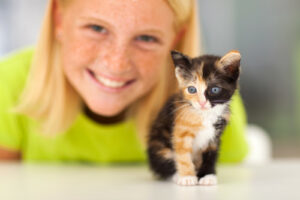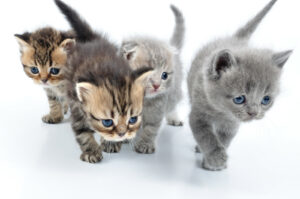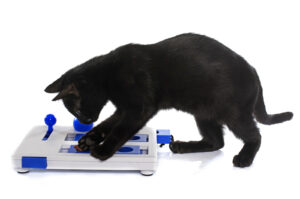Barks Blog
A Good Start in Life
By Francine Miller

Thankfully, more people are now aware that puppies need early socialization to have the best shot at being behaviorally healthy, but there are still many that are sketchy on the details of the process.
Very few people are aware that kittens also undergo a sensitive period, and that socialization during their early weeks can greatly influence their temperament. Bateson (1979) defined a sensitive period as an age range during which particular events are especially likely to have long-term effects on individual development. A sensitive period may best be defined as the period of time when an animal is best able to attend to and be affected by stimuli, which, when missed, puts him at risk for concerns pertaining to those stimuli.
The socialization period is the time when all primary social bonds are formed and constitutes the single most important period during a cat’s life. During this phase, striking behavioral changes occur because of growth and experience. Socialization can occur between a kitten and humans, or between a kitten and his alleged natural enemies, such as dogs and the other unlikely friendships we see so much of on social media. Species identification also occurs during the socialization period. Not only does this permit a cat to recognize other felines, it also teaches him to tolerate, if not fully accept, other cats in social situations.
Although sensitive periods have been emphasized as less important in the development of good pet cat behavior compared to the canine equivalent, feline sensitive periods are shorter, more discreet, and (when a kitten misses out on socialization during this period) more frequently implicated in the development of behavioral problems such as play aggression, inappropriate play behavior, and fear aggression.

socialize a kitten pays off later in life, helping the adult cat’s ability to adapt to a changing environment and be
generally less fearful. Photo (c) Can Stock Photo
A kitten is more likely to have good social behavior if left with his mother and siblings until he is at least 8 weeks of age (12 weeks is preferred) and in an environment with substantial exposure to friendly people. Early development with the queen and siblings teaches kittens to temper play responses; kittens that never learn this may play too aggressively with people. Kittens separated at an earlier age are more likely to be cautious and aggressive.
The American Association of Feline Practitioners – American Animal Hospital Association (AAFP-AAHA) Feline Life Stage Guidelines (2010) state that cats are considered kittens from birth to 6 months old. The critical period for kitten socialization usually occurs during the early weeks of a cat’s life starting between 2 to 7 weeks of age (early socialization occurs between 3-8 weeks, late socialization between 9 and 16 weeks). During this period, the cat becomes used to sights, sounds and smells, as well as how to interact appropriately with other cats, people, and other animals. A young kitten has a fearless, exploratory nature during the socialization period. He may startle easily, but will recover quickly.
The amount of handling a cat receives, the age at which this occurs, and the number of handlers all affect a kitten’s degree of friendliness towards people later in life. Frequent gentle handling and play with varied people including men, women and supervised children is ideal. It is important to encourage the cat to be comfortable with being held, picked up and touched in different places, such as the ears, paws and belly. You can socialize a kitten very well in as little as 15 minutes of daily handling during the sensitive period. Cats that have been handled by only one person can be held for, on average, twice as long by that person than by any other, but cats with experience of four handlers will stay with any person, including a stranger (the multi-person cat becomes socialized to all humans that behave in broadly the same way). Kittens can do this easily until they reach the end of the socialization period, when they become naturally wired to be more suspicious of things they have not yet experienced, so they can react more cautiously to new things in the environment, such as potential predators.
Kitten Garten
If you are lucky enough to have a kitten class available in your area, I would recommend you enroll your kitten immediately. Classes are usually open to kittens from 7 to 14 weeks of age. Kitten classes allow kittens to play together and to be exposed to people of different ages and genders. With positive reinforcement, this exposure helps the kitten to better adapt to all possible changes that may occur in the family and home environment, setting the stage for a lifetime without fear of noises, people, places and experiences. Participating kittens may gain confidence as they travel regularly in the car, play with other kittens and toys and benefit from collecting information and observational learning even if he or she chooses not to interact.
If you don’t have a kitten garten class in your neighborhood, don’t despair. When you bring your kitten home, keep in mind the types of situations your cat will likely be exposed to during his life, and present those situations to him as a kitten. It is essential that these experiences are positive and the kitten does not experience fear in any of the situations presented. Each of these exposures should be presented carefully and with positive reinforcement, by pairing the socialization experience with positive rewards. Should the kitten display signs of fear, make the experience less intense. Present new things in such a way that he can approach a stimulus on his own terms and at his own pace.
You can also create a socialization schedule for your new kitten. For example, get him used to guests in the home so he does not spend the rest of his life hiding when people visit. You can easily do this by inviting friends over for coffee or dinner and finding ways to make the experience rewarding for the kitten. Encourage him to approach your guests and reward him with tasty treats when he does so. Ask your friends to help by playing with the kitten (with a familiar toy) and petting him if he is comfortable with it – accompanied by treats. You could even desensitize and countercondition the kitten to the sound of the doorbell and a knock on the door, as these are often a signal for a cat to run and hide. During this time, you can also introduce tooth brushing, pilling, giving liquid medications via syringe, gentle examination of ears, teeth, nails and grooming, training to a harness and leash for walks outside, car rides, nail clipping, bathing, etc.
It is unfortunate that many cats are not taken to their vet for regular appointments because it is so stressful on the both the cat and the pet parent to transport the cat to and from the hospital. This is why making the cat carrier a safe haven is critical for the rest of your cat’s life. You can do this by keeping the carrier out and accessible in the home to create and maintain a positive association with it by making it a comfortable resting, feeding or play location. You can also place familiar clothing from a favorite person in the carrier and apply Feliway spray (a calming synthetic feline pheromone) just prior to travel. It may also be a good idea to provide a cover or hiding option for your kitten in or over the carrier. Finally, by withholding food prior to travel you may prevent motion sickness and increase interest in treats at the clinic. You have options to help your kitten have a positive veterinary experience. When possible, look for a Fear Free Certified Professional, or find a Cat Friendly Practice®.
The Growing Kitten
Many cat parents who have rescued either a kitten or a cat, experience frightened, shy animals that most likely did not have the benefit of early socialization. Even if these cats would rather not be touched or sit on your lap, they may follow you around, give and seek attention in other ways and form a very close bond with you. If your cat missed out on early socialization (or you simply do not know about your cat’s early life), don’t worry. Behavior can be modified and it is still possible to build a bond. It just may take longer for an adult cat or older kitten to be comfortable with surroundings and people.
Cats need resources and the ability to perform their natural behaviors, as well as having control over their social interactions. Every cat needs a safe place he can retreat to so he feels protected, a place he can also use as a resting place. The cat should have the ability to exit and enter the space from at least two sides if he feels threatened. Most cats prefer that the safe space is big enough to fit only themselves, has sides around it and is raised off the ground.
If you have more than one cat, provide multiple and separated key resources such as food, water, litter boxes, scratching areas, play areas and resting or sleeping areas. Separation of resources reduces the risk of competition and challenges from other cats which may result in stress and behavior problems.

guardians should provide opportunities for play and
predatory behavior; food toys allow cats to forage for
part of their meal, which is a more natural feeding behavior. Photo (c) Can Stock Photo
Provide opportunities for play and predatory behavior. Cats need to fulfill their natural need to hunt. Interactive toys, such as DaBird, that mimic prey are ideal. Allowing the cat to intermittently capture the “prey” and be given a treat as a result will ensure he completes the prey sequence and help prevent frustration, unlike laser pointers that do not direct the cat to prey. (Note: Laser pointers can be an excellent toy for cats if used properly—pointing the laser onto soft toys and treats so the cat can complete the prey sequence.)
In addition, respect the importance of your cat’s sense of smell. Cats use this to evaluate their surroundings and mark their scent by rubbing their face and body, which deposits natural pheromones, to establish boundaries within which they feel safe and secure. Avoid cleaning their scent from these areas, especially when a new cat is introduced into the home, or when there are other changes in people or pets, or in the environment of the home. Be aware that some smells can be threatening to cats, such as the scent of unfamiliar animals or the use of scented products, or detergents.
One excellent way to provide environmental enrichment is to introduce food puzzles so your cat can forage for part of his meal, providing a more natural feeding behavior. Also, provide appropriate places for your cat to scratch throughout the home. Vertical scratching posts should be tall enough that an adult cat can stretch out completely as this is the way they stretch their back and shoulders. Try both vertical and horizontal scratchers, as cats may prefer one over the other. If you need to get your cat interested in a scratcher, use catnip on it, or play a game with him around and over it.
Provide positive, consistent and predictable interaction with your cat. Cats have individual preferences with respect to how much and what kind of interactions they prefer, such as petting, grooming, being picked up and sitting or lying on a person’s lap. To a large extent, this depends on their early socialization. Respect your cat’s individual preferences and don’t force interaction. Instead let the cat initiate, choose and control the type of human contact.
Want to learn more? Consider basic training for your cat. If you have been watching the PPG All About Cats Facebook group, you will have seen some fabulous examples of clicker training for cats. You may also be interested in a new book by John Bradshaw and Sarah Ellis, The Trainable Cat, a Practical Guide to Making Life Happier for You and Your Cat.
References
American Association of Feline Practitioners – American Animal Hospital Association. (2010). Feline Life Stage Guidelines.
Bateson, P. (1979, May). How do sensitive periods arise and what are they for? Journal of Animal Behavior (27) 2 470-486.
Resources
The American Association of Feline Practitioners & International Society of Feline Medicine. (2013). AAFP and ISFM Feline Environmental Needs Guidelines.
Bradshaw, J., & Ellis, S. (2016). The Trainable Cat, a Practical Guide to Making Life Happier for You and Your Cat. New York, NY: Basic Books
Cat Friendly Practice®: www.catfriendly.com/find-a-veterinarian
Fear Free Certified Professional: www.fearfreepets.com/#
Food Puzzles for Cats: www.foodpuzzlesforcats.com
PPG All About Cats: www.facebook.com/groups/512499695617190
This article was first published in BARKS from the Guild, May 2017, pp. 46-48.
About the Author
Francine Miller is an applied animal behavior counselor and associate certified dog behavior consultant (IAABC certified associate) who has 13 years experience treating dogs and cats with behavior problems. She currently offers house calls for behavior consultations throughout San Diego County, California under the business name, Call Ms Behaving and overnight pet sitting in the area around Carlsbad, California where she resides. She is also the vice chairwoman of the PPG Cat Committee.
